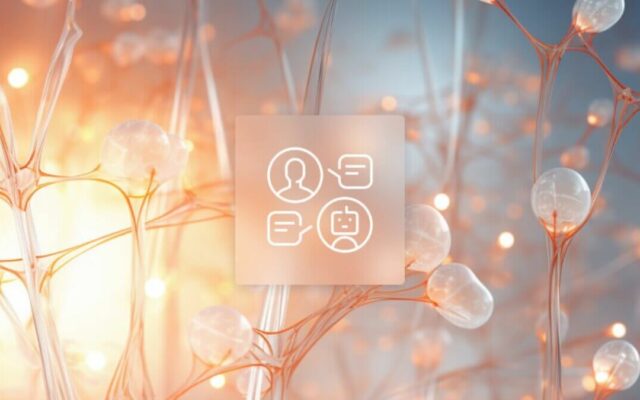Navigating the expansive world of educational chatbots reveals a realm where technology meets academia, fostering student engagement, and offering support. These AI-driven programs, tailored for educational settings, aim to provide enriched learning experiences. It’s incredible, but chatbots have been used in education since the early 1970s.
This article sheds light on such tools, exploring their wide-ranging capabilities, limitations, and significant impact on the learning landscape. We’ll also explore successful examples of university leaders. Read till the end and witness how companies, including Duolingo, leverage innovative technology to make learning accessible to everyone.
Table of Contents
What Are Educational Chatbots All About?
Chatbots for learning are AI-powered digital tools designed specifically for the educational sector. These programs use artificial intelligence and natural language processing to engage with pupils, pedagogs, or administrative staff. Their primary aim is to enhance the teaching moments, streamline tasks, and provide personalized support.
These intelligent assistants are capable of answering queries, providing instant feedback, offering study resources, and guiding educatee through academic content. They function as interactive platforms that facilitate communication. Besides, institutions can integrate bots into knowledge management systems, websites, or standalone applications. Such solutions lead to efficient learning and administrative supervision.
Benefits of Chatbots in Higher Education and Not Only

Digital assistant integration significantly changes the way learners engage in studying processes, offering an array of benefits. Here are some core advantages.
Increased Engagement
AI implementation promotes higher engagement by supplying interactive learning experiences, making the process more enjoyable. The study shows that 90.7% of participants expressed satisfaction with the experiential learning chatbot workshop, while 81.4% felt engaged. Through tailored interactions, quizzes, and real-time discussions, bots perfectly captivate users’ attention.
Accessible and Inclusive
These AI-driven tools create an inclusive studying environment by catering to diverse educational styles and abilities. They offer adaptable content formats, such as audio, visual, and text-based materials, ensuring accessibility for all users, regardless of their needs.
Instant Feedback
One of the significant advantages of chatbots in education industry is their ability to offer immediate feedback. This quick response mechanism is capable of asking about specific aspects of the session or course. Such programs gather comments on various subjects like study material, teaching approaches, assignments, and more. Likewise, bots can collect inputs from all involved participants after each interaction or event. Subsequently, this method offers valuable insights into improving the learning journey.
Personalized Content
Chatbots excel in delivering personalized learning opportunities. Roughly 92% of students worldwide demonstrate a desire for personalized assistance and updates concerning their academic advancement. By analyzing pupils’ learning patterns, these tools customize content and training paths. Such a unique approach ensures that everyone receives tailored support, promoting better comprehension and knowledge retention.
24/7 Availability
Digital assistants offer continuous support and guidance to all trainees, regardless of time zones or schedules. This constant accessibility allows learners to seek support, access resources, and engage in activities at their convenience. This is why 99% of students think 24/7 support is important.
Cost-effectiveness

Implementing chatbots in education proves to be a cost-effective solution for institutions. These tools significantly reduce operational costs by automating routine tasks, streamlining administrative processes, and minimizing the need for additional human resources. Accordingly, bots in the educational sector have the potential to reduce customer service expenses by more than 30% (ZipDo).
Limitations of Educational Chatbots and Why It’s Vital to Address Them
While AI models offer numerous benefits, these limitations highlight the importance of continuous improvements. Addressing the main restrictions can lead to more robust and efficient chatbot implementations.
Perceived Ease of Use
The success of chatbot implementation depends on how easily educatee perceive and adapt to their use. If they find tools complex or difficult to navigate, it may hinder their acceptance and application in educational settings. Ensuring a user-friendly interface and straightforward interactions is important for everyone’s convenience.
Perceived Organizational Support
Students’ perception of institutional support for chatbot integration influences their acceptance. If someone feels inadequate support or lacks institutional backing for bot usage in their academic journey, it could result in reluctance or skepticism towards engaging with these tools.
Perceived Risk
Concerns about data security, privacy, or the accuracy of information provided by AI models may hinder their adoption. Customers may hesitate to fully trust or rely on these tools due to perceived risks associated with potential errors or data breaches.
Lack of Emotional Intelligence
AI systems may lack the emotional understanding and sensitivity required for dealing with complex sentimental concerns. In educational establishments where mental support is essential, the absence of sensitive intelligence in chatbots can limit their effectiveness in addressing users’ personal needs.
Lack of Creativity
These programs may struggle to offer innovative or creative solutions to complex problems. This limits their ability to stimulate critical thinking or problem-solving skills. This limitation could impact the overall effectiveness of such tools in promoting creative learning approaches.
Master of Code Global specializes in effective chatbot development solutions. We use advanced encryption and follow strict data protection rules, creating a secure space to engage with the bot, assuring users of their data privacy. Moreover, our projects are tailored to each client’s needs, resolving customer pain points. So, partnering with us for your future chatbot development is a one-stop solution to address all concerns from the above.
What for: Chatbots Use Cases in Education Explained

Education reaches far beyond the classroom, requiring guidance and support across the entire campus life. In this part, we will explore how AI-powered tools give a hand in learning processes, assist with homework or simplify data collection.
Tutoring
Educational chatbots serve as personal assistants, offering individual guidance to everyone. Through intelligent tutoring systems, these models analyze responses, learning patterns, and overall performance, fostering tailored teaching. Bots are particularly beneficial for neurodivergent people, as they address individual comprehension disabilities and adapt study plans accordingly.
By transforming lectures into conversational messages, such tools enhance engagement. This method encourages students to ask questions and actively participate in processes comfortably. As a result, it significantly increases concentration level and comprehensive understanding.
Additionally, tutoring chatbots provide personalized learning experiences, attracting more applicants to educational institutions. Moreover, they contribute to higher learner retention rates, thereby amplifying the success of establishments.
Engagement
Student involvement is crucial for establishing trust and commitment. Here chatbots play an important role, as they can track progress, ensuring continuous interaction through personalized content and suggestions. Since pupils seek dynamic learning opportunities, such tools facilitate student engagement by imitating social media and instant messaging channels.
Digital assistants address queries and exchange information regarding lectures, assignments, or events. This interactive solution aligns with dynamic educational experiences. Furthermore, institutions leveraging chatbots witness higher conversion rates, thereby contributing to overall success.
Assistance
Overloaded due to tight scheduling and plenty of daily duties, educators often face challenges. Invaluable teaching assistants can give a hand with automation tasks like tests, assessments, and assignment tracking. EdWeek reports that, according to Impact Research, nearly 50% of teachers utilized ChatGPT for lesson planning and generated creative ideas for their classes.
These bots offer individualized support to learners, providing guidance, and aiding in workload management for both teachers and educatee. By streamlining routine activities, chatbots help pedagogues focus on delivering high-quality knowledge and monitoring attendees’ progress.
For instance, if trainees were absent, the bot could send notes of lectures or essential reminders, to keep them informed while they’re not present. After all, using educational software simplifies administrative work. This efficiency contributes to a more enriching learning experience, consequently attracting more students.
Support
AI chatbots for education offer backup throughout university life, from the admission process to post-course assistance. They act beyond classroom activities as campus guides, providing valuable information on facilities and helping students. Considering this, the University of Murcia in Spain used an AI chat assistant that successfully addressed more than 38,708 inquiries with an accuracy rate of 91%.
Ivy Tech Community College in Indiana developed a machine learning algorithm to identify at-risk students. Their experiment aided 3,000 participants, and 98% of those who received support achieved a grade of C or higher.
The e-learning showed the need for exceptional support, especially in the wake of COVID-19. AI implementation caters to inquiries promptly, providing instant solutions. Supplying robust aid through digital tools enhances the institution’s reputation, especially in the rapidly growing e-learning market.
Data Collection
Almost all institutions aim to streamline their processes of updating and collecting data. By leveraging AI technology, colleges can efficiently gather and store information. Such optimization will eliminate student involvement in updating their details.
As a rule, this advanced data collection system enhances administrative efficiency and enables institutions to use pupils’ information as necessary. Such a streamlined approach will assist learning centers in reducing manual efforts required for materials update, thereby fostering convenient resource utilization.
Holiday Homework
During holiday periods, when learners might face difficulties reaching teachers, chatbots become valuable tools for assistance. They facilitate communication of homework details, schedules, and answer queries. Furthermore, they aid in conducting assessments, even in courses requiring subjective evaluations.
According to the survey conducted among 1,000 secondary school attendees, 67% of learners admitted using AI tools. What’s more interesting is that 42% of those surveyed apply this technology in math, while 41% use it for writing essays.
Through AI and ML capabilities, bots help to access relevant materials and submit tasks. Implementing innovative technologies, establishments will ensure continuous learning beyond the classroom. In such a way, institutions commit to academic excellence and foster positive student experiences.
Assessment
AI-powered chatbots can help automate assessment processes by accessing examination data and learner responses. These indispensable assistants generate specific scorecards and provide insights into learning gaps. Timely and structured delivery of such results aids students in understanding their progress, showing the areas for improvement.
The streamlined evaluation process offers precise evaluations of student performance. This gives transparent and structured assessment outcomes to educatee, faculty, and stakeholders.
Administration
Chatbots ease administrative processes, serving as an efficient interface between students and departments. They help in obtaining information on fee structures, course details, scholarships, and school events. By digitizing enrollment processes and simplifying communication channels, bots reduce the workload for staff.
Involving AI assistants in administrative tasks raises the overall efficiency of educational institutions, reducing wait times for students. This efficiency contributes to higher satisfaction levels among educatee and staff, positively impacting the institution’s credibility.
Alumni Interaction
Chatbots for educational institutions may establish connections with alumni. This implementation will ease data collection for reference and networking purposes. Using such models, institutions can engage with graduates, fostering a sense of community.
Moreover, this will provide opportunities for mentorship and collaboration between current attendees and alums. Thereby, chatbots assist in building and nurturing a robust grads network. Such a contribution also offers networking opportunities and support for current students. Additionally, this will positively impact the brand image, attracting potential applicants and stakeholders.
The Most Successful Education Chatbot Examples from EdTech Leaders
Cara Virtual Assistant
Cara is the virtual assistant for the University of Galway. This AI chatbot for higher education addresses inquiries about various aspects from the admission process to daily academic life. These range from guidance on bike parking or locating specific classrooms to offering support during times of loneliness or illness. Cara also provides insights into what’s bugging students and helps them engage with the university.
Every week, we look at ‘what’s hot’ on Cara, what’s trending, and we look at what’s happening in our physical center as well as what our student advisors are hearing from students, which then dictates our next steps,
Learners can reach Cara on the university website or WhatsApp and get an answer instantly without having to wait for a staff member.
Pounce AI Chatbot
Georgia State University has effectively implemented a personalized communication system. They introduced Pounce, a bespoke smart assistant created to actively engage admitted students.
Clearly this was having a bigger impact than just the emails, and part of that was because they were receiving the message. I did not expect we’d get this overwhelming evidence that the chatbot is this effective.
Pounce provides various essential functions, including sending reminders, furnishing relevant enrollment details, gathering survey data, and delivering round-the-clock support. The primary objective behind Pounce’s introduction was to streamline the admission process.
Duolingo Max
Duolingo’s goal is to create high-quality education available to everyone in the world. To enhance the app, the team leveraged GPT-4 technology into Duolingo Max. Their users got access to generative AI features: Explain My Answer and Roleplay.
We wanted AI-powered features that were deeply integrated into the app and leveraged the gamified aspect of Duolingo that our learners love.
The Explain My Answer option provides learners with an opportunity to delve deeper into their responses. By selecting a button following specific exercise types, users engage in a chat with Duo, receiving a concise explanation about their answers. They can also seek examples or additional clarification as needed.
Roleplay enables users to hone their conversational abilities by engaging with virtual characters. Lerners get the opportunity to simulate diverse scenarios, such as planning future vacations, ordering coffee at a Parisian café, shopping for furniture, or inviting a friend for a hike.
Key Takeaways
To summarize, the journey through educational chatbots has uncovered a field of possibilities. These AI tools amplify engagement, offer personalized content, and ensure uninterrupted support. Yet, the limitations of these bots, such as lack of emotional intelligence, demand further attention. But the success stories of the University of Galway and Georgia State University, reveal the transformative potential of such models.
These amazing cases encourage further development and refinement in this dynamic sphere. If you are ready to apply conversational AI in education industry, Master of Code Global will bridge the gap between technologies and your ideas!







